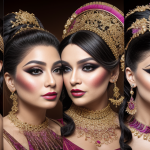Are you considering wearing a wig but concerned about its impact on your hair? Well, let’s put those worries to rest! In this article, we’ll dive into the world of wigs and explore whether they can be a healthy choice for your hair. From the benefits of wig-wearing to the precautions you should take, we’ve got you covered. So, buckle up and get ready to discover the truth about wigs and your hair!
Wearing a wig can have both positive and negative effects on your hair. On one hand, wearing a wig can provide a break for your natural hair, allowing it to rest and recover from damage. It can also be a great way to experiment with different hairstyles without damaging your own hair. On the other hand, wearing a wig can cause tension on your scalp and lead to hair loss if the wig is not properly secured. Additionally, wearing a wig can cause your natural hair to become frizzy and dry due to the friction between the wig and your scalp. Ultimately, whether or not wearing a wig is good for your hair depends on your individual hair type and how you take care of your hair while wearing a wig.
The benefits of wearing a wig
================================
Wearing a wig can provide a number of benefits for individuals looking to enhance their appearance or cover up hair loss. Here are some of the advantages of wearing a wig:
Protects hair from damage
Wigs can protect natural hair from damage caused by styling tools, chemicals, and environmental factors such as sunlight and wind. By wearing a wig, individuals can prevent their hair from being exposed to these elements, which can help to keep it healthy and strong.
Allows for experimentation with style
Wigs offer the opportunity to experiment with different styles and colors without damaging natural hair. Whether you want to try a bold new look or simply want to switch things up, wigs provide a convenient and low-commitment way to do so.
Provides a solution for hair loss
For individuals experiencing hair loss, wigs can be a practical and effective solution. By wearing a wig, individuals can cover up thinning or balding areas, allowing them to feel more confident and comfortable in their own skin.
Saves time and effort
Wigs can save time and effort in the morning by eliminating the need to style your hair. With a wig, you can simply throw on a new style in minutes, making your morning routine much simpler and easier.
In conclusion, wearing a wig can provide a number of benefits for individuals looking to enhance their appearance or cover up hair loss. Whether you’re looking to protect your natural hair, experiment with style, or provide a solution for hair loss, wigs offer a convenient and effective option.
Concealing hair loss
Wearing a wig can be a confident-boosting solution for those experiencing hair loss. Hair loss can be a sensitive issue for many individuals, causing them to feel self-conscious and unconfident. A wig can provide a simple and effective way to conceal hair loss, allowing individuals to feel more presentable and put-together.
Additionally, wearing a wig can provide a temporary solution for those undergoing chemotherapy or other treatments that cause hair loss. This can help individuals maintain a sense of normalcy and maintain their appearance during a difficult time.
Furthermore, wearing a wig can also be a way to experiment with different hairstyles and colors without permanently damaging one’s own hair. This can be especially appealing for those who are looking to try a new look but are hesitant to make a permanent change.
Overall, wearing a wig can be a valuable tool for those experiencing hair loss, providing a simple and effective way to conceal hair loss and boost confidence.
Saving time and effort
Wigs can be a convenient solution for those who want to save time and effort on their hair care routine. Here are some ways in which wearing a wig can help:
- Wigs eliminate the need for daily styling and maintenance: With a wig, you don’t have to worry about washing, conditioning, blow-drying, or styling your hair every day. This can save you a significant amount of time and effort, especially if you have long hair.
- A convenient option for those with busy lifestyles: For people with busy schedules, wearing a wig can be a practical solution. You can quickly style your hair by just putting on a wig, which is especially useful for work or special occasions. You don’t have to worry about running out of time to style your hair in the morning or rushing to get ready for a date.
Additionally, wigs can be a great option for people who have hair loss or thinning hair due to medical conditions like alopecia or chemotherapy. Wearing a wig can help them regain their confidence and feel more comfortable in their own skin.
Overall, wearing a wig can be a great way to save time and effort on your hair care routine, while still looking stylish and put-together.
Experimenting with different styles
Wigs provide a convenient and safe way to experiment with different hairstyles without causing any damage to your natural hair. This can be especially beneficial for individuals who have difficulty growing their hair or those who suffer from hair loss due to medical conditions or treatments.
With a wig, you can try out a variety of styles, from short and spiky to long and flowing. You can even try out different colors and textures, giving you the opportunity to express your creativity and try out new looks. Whether you want to try out a bold and vibrant style or a more subtle and sophisticated look, a wig can help you achieve your desired style without the need for extensive hair treatments or styling.
Wearing a wig can also be a great way to add some variety to your look and try out different styles without committing to a permanent change. You can easily switch up your style by trying out a different wig, allowing you to experiment with different looks without having to cut or color your own hair.
In addition to being a convenient and safe way to experiment with different styles, wearing a wig can also be a great way to boost your confidence and self-esteem. With a variety of styles to choose from, you can find a wig that complements your features and enhances your natural beauty, giving you the confidence to try out new looks and express your unique style.
Overall, wearing a wig can be a great way to experiment with different hairstyles and try out new looks without causing any damage to your natural hair. Whether you want to try out a bold and vibrant style or a more subtle and sophisticated look, a wig can help you achieve your desired style and boost your confidence and self-esteem.
Hair care benefits
- Wigs can help protect natural hair from damage caused by heat styling or environmental factors
- Heat styling can cause irreversible damage to the hair, including breakage, split ends, and dryness. Wigs can protect the natural hair from these damaging effects, as they do not require heat to style.
- Environmental factors such as pollution, sun exposure, and wind can also cause damage to the hair. Wigs can protect the hair from these factors, as they act as a barrier between the hair and the environment.
- Allows natural hair to grow and repair itself without being constantly styled
- When the hair is constantly styled, it can become weak and brittle, leading to breakage and split ends. Wigs allow the natural hair to grow and repair itself without the need for constant styling.
- Wigs can also allow the natural hair to rest, as they can be worn on days when the hair is not washed or styled. This can help the hair to retain moisture and maintain its natural oils, leading to healthier-looking hair.
The drawbacks of wearing a wig
=================================
While wearing a wig may seem like a convenient solution for those experiencing hair loss or looking to change their hairstyle, there are several drawbacks to consider.
One major drawback is the discomfort that can come with wearing a wig. The wig may be tight and uncomfortable, and can cause headaches and itching. This discomfort can be particularly pronounced when wearing a wig for an extended period of time, such as during a hot summer day.
Another drawback is the risk of infection. Wigs can harbor bacteria and fungi, which can cause skin irritation and infections. This is particularly true for those who wear a wig that is not made from their own hair, as there is a higher risk of bacterial and fungal overgrowth.
Additionally, wearing a wig can cause damage to your own hair. This is because the wig can cause friction and tension on your scalp, which can lead to hair breakage and thinning over time. This is particularly true for those who wear a wig that is not properly fitted or styled, as it can cause excessive pulling and tension on the hair.
Furthermore, wearing a wig can be expensive. High-quality wigs can cost hundreds or even thousands of dollars, and the cost of maintenance and upkeep can add up over time. This is particularly true for those who need to purchase multiple wigs to achieve different styles or colors.
Finally, wearing a wig can be time-consuming and labor-intensive. It may require special care and maintenance, such as regular washing and styling, which can take up a significant amount of time. Additionally, the process of applying and removing the wig can be cumbersome and time-consuming, particularly for those who need to wear it for extended periods of time.
Cost
Wearing a wig can be an expensive proposition, especially if you’re looking for high-quality wigs that look and feel like your own hair. The cost of a wig can vary depending on the type of wig, the materials used, and the brand, but in general, wigs can range from a few hundred to several thousand dollars.
One of the biggest expenses associated with wearing a wig is the initial cost of purchasing the wig itself. High-quality wigs made from real human hair can cost several thousand dollars, while synthetic wigs are typically less expensive but still cost hundreds of dollars. In addition to the initial cost, you may also need to purchase additional wigs to replace your current one, which can add up over time.
The cost of maintaining a wig can also be significant. Wigs require regular care and maintenance, including washing, conditioning, and styling, which can add up over time. In addition, you may need to have your wig professionally cleaned and styled, which can add to the overall cost.
It’s important to keep in mind that while wigs can be an effective solution for hair loss or other hair-related issues, the cost of wearing a wig can add up over time. It’s important to factor in the cost of purchasing and maintaining a wig when considering whether or not to wear one.
Maintenance
Wearing a wig may seem like an easy way to change up your hairstyle, but it comes with its own set of maintenance requirements.
- Brushing and cleaning: One of the most important aspects of wig maintenance is regular brushing and cleaning. Just like natural hair, wigs can become knotted and dirty, and failure to maintain them properly can lead to damage and a shorter lifespan for the wig. It’s important to use a gentle wig brush and to be thorough when cleaning the wig to ensure that it stays in good condition.
- Heat damage: Another potential issue with wearing a wig is the risk of heat damage. Many people like to style their wigs using heat tools like curling irons or flat irons, but this can cause damage to the fibers of the wig and shorten its lifespan. It’s important to be cautious when using heat on a wig and to avoid exposing it to excessive heat for long periods of time.
Overall, while wearing a wig can be a convenient way to change up your look, it’s important to be aware of the maintenance requirements involved and to take proper care of your wig to ensure that it lasts as long as possible.
Comfort
Wearing a wig can be a great way to cover up hair loss or to change one’s appearance for a special occasion. However, it is important to consider the potential drawbacks of wearing a wig, particularly when it comes to comfort.
- Itchiness: One of the most common complaints about wearing a wig is that it can be itchy. This is because the wig material can rub against the scalp and cause irritation. The itchiness can be particularly pronounced if the wig is made of synthetic materials or if it is not properly fitted.
- Discomfort: In addition to itchiness, wearing a wig can also be uncomfortable. This is because the wig can be heavy and hot, particularly if it is made of thick, synthetic materials. The discomfort can be exacerbated by the fact that the wig is not attached to the scalp, which means that it can move around and cause discomfort.
- Headaches: Some people may experience headaches while wearing a wig. This is because the wig can be heavy and can put pressure on the scalp and the head. Additionally, the wig may be uncomfortable to wear for extended periods of time, which can contribute to headaches.
- Skin irritation: Wearing a wig can also cause skin irritation. This is because the wig can rub against the scalp and cause friction, which can lead to redness and irritation. Additionally, the glue or tape used to attach the wig to the scalp can cause skin irritation.
Overall, while wearing a wig can be a great way to change one’s appearance, it is important to consider the potential drawbacks, particularly when it comes to comfort. If you are experiencing itchiness, discomfort, headaches, or skin irritation while wearing a wig, it may be worth considering other options.
Health concerns
Wearing a wig can have potential health concerns if not properly cared for. One of the main concerns is the risk of bacterial and fungal infections. If a wig is not cleaned and maintained regularly, it can harbor bacteria and fungus, which can lead to skin irritation, rashes, and even hair loss. It is important to follow proper hygiene practices when wearing a wig, such as washing the scalp regularly and cleaning the wig with a specialized shampoo and conditioner.
Another health concern related to wearing a wig is the risk of allergic reactions. Some people may be allergic to the materials used in wigs, such as synthetic fibers or latex. These allergies can cause skin irritation, rashes, and other reactions. It is important to test for allergies before wearing a wig, and to choose a wig made from materials that are known to be hypoallergenic.
In addition to these health concerns, wearing a wig can also cause tension on the scalp and hair follicles, which can lead to hair damage and hair loss over time. It is important to consult with a hair care professional before deciding to wear a wig, to ensure that it is the right choice for your hair type and health.
Is wearing a wig the right choice for you?
Wearing a wig can be a great solution for those who are experiencing hair loss or want to change their hairstyle without damaging their natural hair. However, whether or not wearing a wig is the right choice for you depends on several factors. In this section, we will discuss some of the things you should consider before deciding to wear a wig.
Pros of wearing a wig
- Convenience: Wearing a wig can be a convenient way to change your hairstyle without the need for expensive or time-consuming treatments.
- Low maintenance: Unlike natural hair, wigs require minimal maintenance. You don’t have to worry about washing, conditioning, or styling your wig, making it a great option for busy individuals.
- Temporary solution: Wigs can be a temporary solution for those who are experiencing hair loss due to chemotherapy, alopecia, or other medical conditions. They can help you maintain a normal appearance and confidence during treatment.
Cons of wearing a wig
- Comfort: Wigs can be uncomfortable to wear, especially if they are not properly fitted or made from a breathable material. They can cause itching, sweating, and headaches, which can be unpleasant for some people.
- Cost: High-quality wigs can be expensive, and you may need to purchase multiple wigs to achieve different styles. Additionally, you may need to pay for wig maintenance, such as cleaning and styling.
- Perception: Some people may view wig-wearing as a sign of vanity or insecurity, which can affect how you are perceived by others.
Factors to consider
- Hair type: If you have curly or thick hair, a wig may not be the best option for you. Wigs can make your hair appear more wavy or frizzy, and they may not be able to hold a style as well as natural hair.
- Lifestyle: If you lead an active lifestyle, a wig may not be the best option for you. Wigs can be cumbersome and may get in the way of activities such as sports or dancing.
- Personal preferences: Ultimately, whether or not wearing a wig is the right choice for you depends on your personal preferences. Some people may feel more comfortable wearing a wig, while others may prefer to embrace their natural hair.
In conclusion, wearing a wig can be a great option for those who want to change their hairstyle or cover up hair loss. However, it is important to consider the pros and cons and to think about your personal preferences and lifestyle before making a decision.
Factors to consider
- Hair loss or hair goals
- Hair loss can be caused by a variety of factors, including genetics, hormonal imbalances, medical conditions, and treatments such as chemotherapy. If you are experiencing hair loss, wearing a wig may be a good option to help you regain a fuller, more confident appearance. However, if your hair loss is caused by a medical condition, it is important to consult with a healthcare professional before wearing a wig to ensure that it is safe and appropriate for your specific situation.
- On the other hand, if your hair goals are to change your appearance or try out a new style, wearing a wig can be a convenient and low-commitment way to do so. You can experiment with different colors, lengths, and textures without damaging your natural hair.
- Lifestyle and schedule
- Wearing a wig can be a great option for those with busy lifestyles or who do not have time to maintain a traditional hair care routine. Wigs require minimal maintenance and can be easily styled, washed, and dried at home. They are also a convenient option for special occasions or events when you want to look your best.
- Budget and financial considerations
- Wigs can range in price from affordable to expensive, depending on the quality, materials, and brand. If you have a limited budget, you may want to consider purchasing a synthetic wig, which is generally less expensive than a human hair wig. You can also purchase a wig cap or tape-in hair extensions to add volume or length to your natural hair without the need for a full wig.
- Personal preferences and comfort level
- Ultimately, the decision to wear a wig should be based on your personal preferences and comfort level. Some people may feel self-conscious or uncomfortable wearing a wig, while others may find it empowering and liberating. It is important to choose a wig that fits well, feels comfortable, and reflects your personal style.
Making an informed decision
Wearing a wig can be a great option for those experiencing hair loss or looking to change up their hairstyle. However, it’s important to make an informed decision before committing to wearing a wig. Here are some steps to take when considering whether a wig is the right choice for you:
Consult with a hair care professional
Before making any decisions about wearing a wig, it’s important to consult with a hair care professional. They can help you determine the cause of any hair loss you may be experiencing and recommend the best course of action. They can also advise you on the type of wig that would be best for your hair type and desired style.
Research different types of wigs and their benefits/drawbacks
There are many different types of wigs available, each with their own unique benefits and drawbacks. Some wigs are made from real human hair, while others are made from synthetic materials. Some wigs are designed to be worn for a short period of time, while others are designed to be worn for longer periods. Researching the different types of wigs can help you determine which one would be the best fit for your needs.
Consider trying on a wig before making a purchase
Before making a purchase, it’s a good idea to try on a wig to see how it looks and feels. This can help you determine if the wig is a good fit for your head and if it’s the right style for you. Some wig shops may offer the option to try on a wig before purchasing, while others may require you to purchase the wig first and then return it if it doesn’t work out.
Weigh the pros and cons and decide what is best for you
After consulting with a hair care professional, researching different types of wigs, and trying on a wig, it’s time to weigh the pros and cons and decide what is best for you. Consider the cost, maintenance requirements, and how it will affect your daily life. It’s important to choose a wig that makes you feel confident and comfortable, rather than one that simply looks good on paper.
FAQs
1. Is wearing a wig good for your hair?
Answer:
There is no definitive answer to whether wearing a wig is good or bad for your hair, as it can depend on various factors such as the type of wig, the condition of your hair, and how you take care of both. However, some benefits of wearing a wig include providing a protective barrier for your natural hair, allowing you to style your hair without damaging it, and providing a convenient solution for those experiencing hair loss or undergoing chemotherapy.
2. Can wearing a wig damage your hair?
While wearing a wig may not directly damage your hair, improper care or wearing a wig that is not made for your hair type can cause damage. It is important to choose a wig made from high-quality materials and to take proper care of it to prevent damage to your hair. Additionally, if you are wearing a wig daily, it is important to take breaks to give your natural hair a chance to breathe and recover.
3. Can wearing a wig cause hair loss?
Wearing a wig should not cause hair loss, but it is important to take proper care of your natural hair to prevent hair loss. If you are experiencing hair loss, it is important to consult with a doctor or a dermatologist to determine the underlying cause and to receive appropriate treatment. It is also important to follow proper care instructions for your wig to prevent damage to your hair and to extend the life of your wig.
4. How often should I wear a wig?
The frequency of wearing a wig depends on your personal preference and the reason for wearing it. If you are wearing a wig for a special occasion or as a fashion statement, you may choose to wear it less frequently. If you are wearing a wig due to hair loss or other medical conditions, you may need to wear it more frequently. It is important to listen to your body and to take breaks from wearing a wig as needed to give your natural hair a chance to recover.
5. Can I wear a wig with my natural hair?
Yes, you can wear a wig with your natural hair. Many people choose to wear a wig as a way to add volume or length to their natural hair, or to try out a new style without damaging their hair. When wearing a wig with your natural hair, it is important to use a wig cap or a hair net to prevent your natural hair from getting tangled or damaged. Additionally, it is important to choose a wig that is made from high-quality materials and that is compatible with your hair type to prevent damage and to ensure a natural look.









